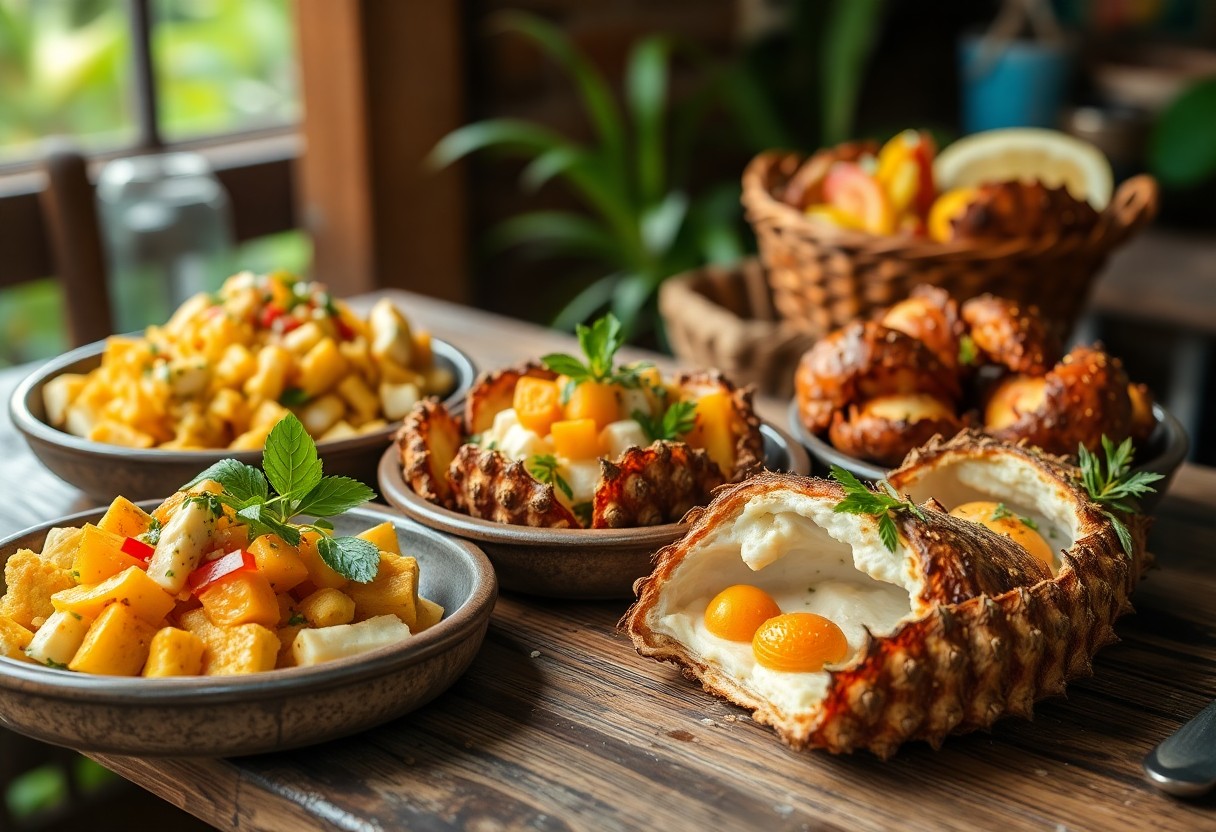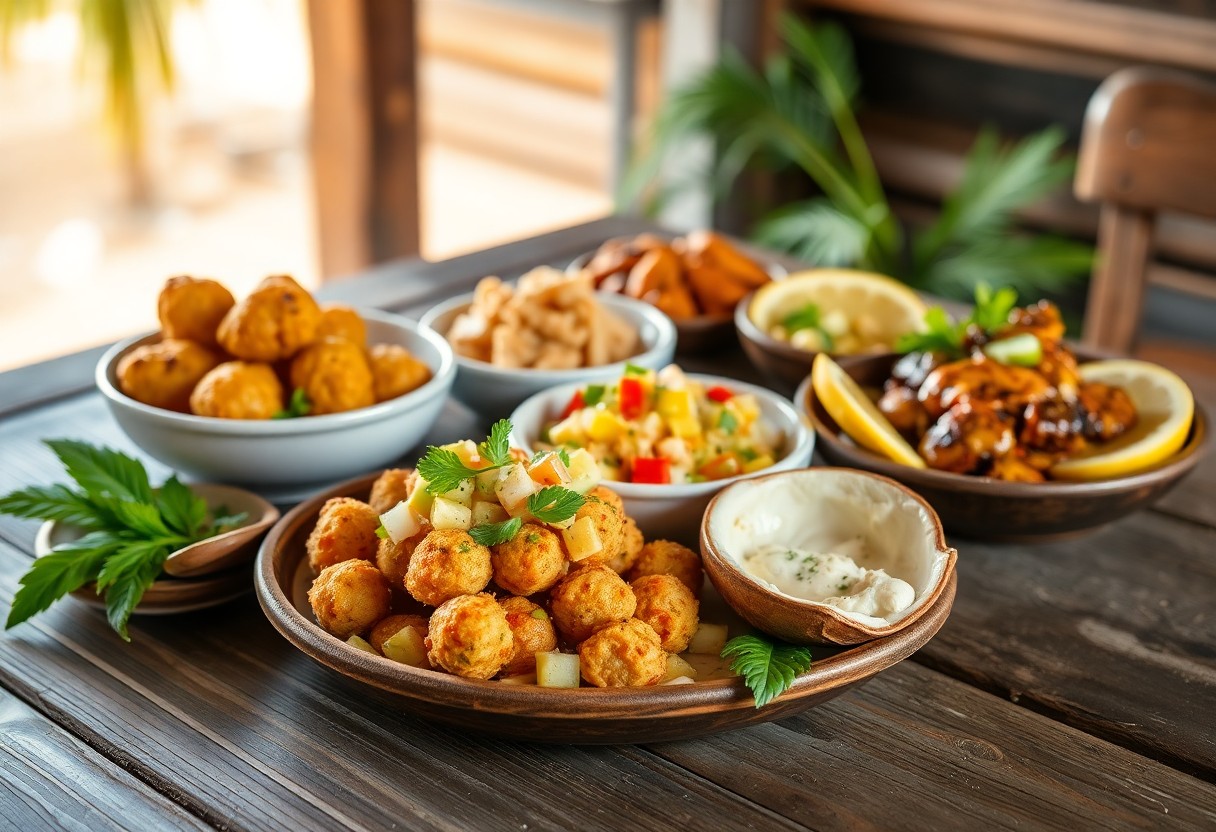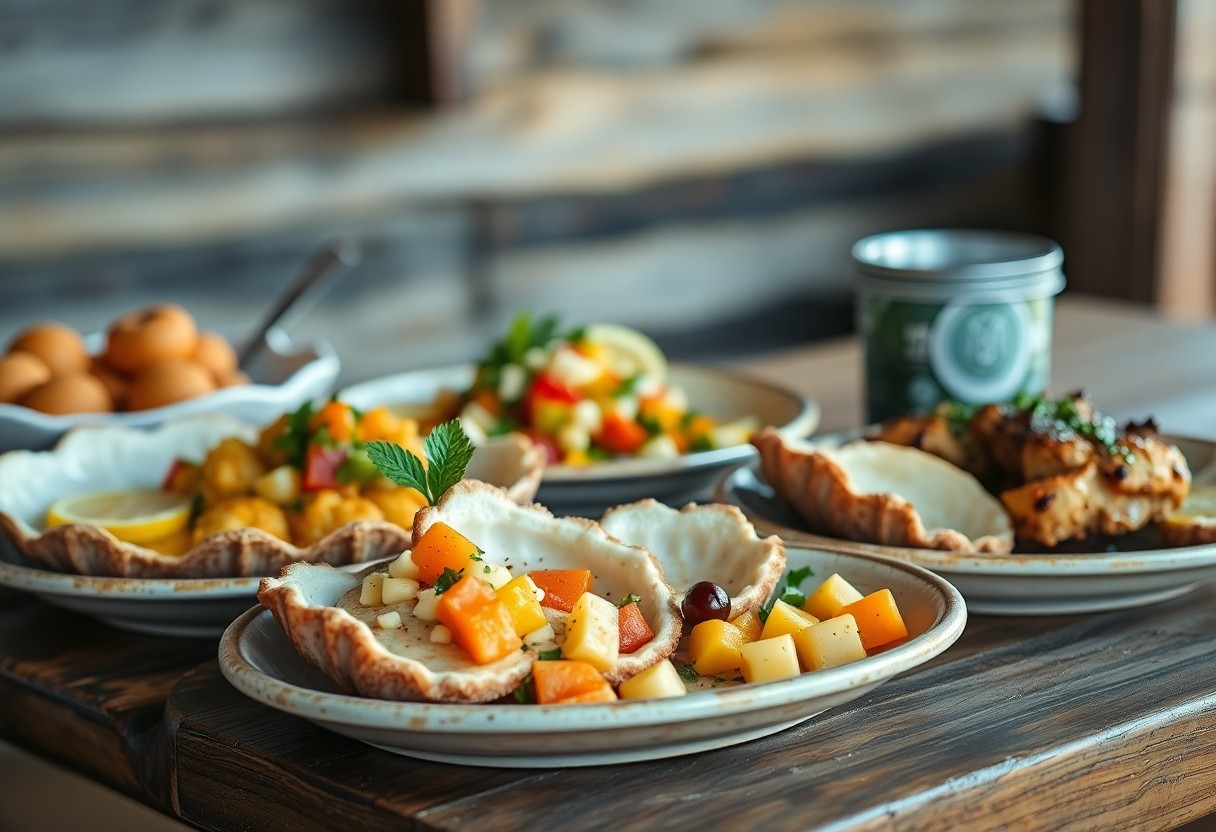The arrival of Conch season signifies one of the most anticipated culinary experiences along the Caribbean coastline, offering a unique opportunity to embark on a delightful gastronomic journey! As a renowned seafood delicacy, Queen Conch offers a distinctive combination of sweet and tender meat that is artfully transformed into a variety of mouthwatering dishes by local chefs. Throughout the islands, you will discover a plethora of preparations for these marine mollusks, ranging from fresh, raw delicacies to expertly cooked options. Your culinary adventure is set to begin with locally sourced, sustainable catches readily available from certified vendors. However, before indulging in these exquisite delicacies, it’s crucial to familiarize yourself with the local fishing regulations and seasonal restrictions to ensure responsible consumption of this protected species.

Explore the Enchanting Culinary Landscape of Queen Conch
The Queen Conch (Strombus gigas) is a remarkable marine mollusk that thrives in the warm, inviting waters of the Caribbean Sea. This protected species has evolved into a cultural icon within Caribbean cuisine, celebrated for its striking pink shell and the highly coveted meat that provides an extraordinary range of flavors. Beyond serving as a food source, the conch holds a significant place in the region's tradition and heritage, making it an essential element of the local culinary identity and cultural practices.
Understanding the Key Attributes and Seasonal Harvesting of Queen Conch
In Belize, any Queen Conch you come across will be harvested during the legally designated season from October 1 to June 30. Your chances of encountering these fascinating creatures are highest in shallow waters, where they actively forage on seagrass and algae. The conch meat has a firm texture and a light, sweet flavor profile, making it an ideal ingredient for various culinary creations. By understanding the life cycle and natural habitat of Queen Conch, you'll gain a deeper appreciation for this remarkable seafood and its vital role in the ecosystem.
Discovering the Remarkable Nutritional Advantages of Queen Conch
Even a modest serving of conch meat can provide your body with high-quality protein and essential nutrients. When you enjoy conch, you receive a significant amount of vitamin B12, iron, and magnesium while keeping your calorie intake low. Importantly, the meat is naturally low in fat and rich in lean protein, making it an excellent choice for health-conscious diners seeking nutritious options.
Moreover, conch meat offers nutritional benefits that go beyond mere sustenance. A serving size of just 3 ounces can fulfill a substantial portion of your daily protein requirements, providing approximately 22 grams of protein. Additionally, the meat is a source of omega-3 fatty acids, known for their positive effects on heart health, along with valuable minerals like selenium and vitamin E that contribute to a strong immune system and overall well-being.
Diving into the Diverse and Flavorful Dishes Featuring Queen Conch
Prepare yourself to explore the variety of delicious ways to enjoy Queen Conch within the rich tapestry of local culinary traditions. From raw delicacies to expertly cooked meals, each dish emphasizes the unique sweet-salty flavor profile that makes this seafood so beloved. Your culinary exploration of these diverse preparations will reveal why Queen Conch is a mainstay in Caribbean gastronomy and delight your taste buds with every delectable bite.
Relishing in Traditional Conch Preparations
If you’re eager to experience authentic conch cuisine, your journey should undoubtedly begin with conch ceviche and conch fritters. These traditional recipes, lovingly passed down through generations, capture the essence of Caribbean flavors and culinary heritage. You can find these delightful dishes served at local restaurants and beachside eateries throughout Belize during the official conch season, from October 1 to June 30, making them a must-try for any food lover looking to savor local flavors.
Innovative Culinary Creations Showcasing Conch
Modern chefs are reimagining traditional conch recipes, transforming them into exciting new culinary experiences. Today, you can indulge in conch tacos, conch pasta, and even unique conch sushi rolls. These innovative dishes maintain the seafood’s inherent flavors while introducing contemporary culinary twists that invigorate your palate and elevate your dining experience.
To further enhance your dining experience, many local restaurants now offer fusion dishes that creatively blend Caribbean flavors with influences from international cuisines. You can enjoy conch spring rolls, conch wontons, and conch bruschetta, each showcasing the versatility of conch while honoring its delicate texture and taste in every bite.

Mastering Essential Techniques for Preparing Queen Conch
Once you have fresh Queen Conch, mastering proper preparation techniques is crucial for creating delectable dishes that highlight its unique flavors. Here are some vital steps to follow:
- Carefully extract the conch from its shell using a hammer and chisel to ensure you retain the integrity of the meat.
- Thoroughly clean the meat to eliminate any dark skin and internal organs, ensuring a fresh flavor.
- Score the meat in a cross-pattern to enhance seasoning absorption and improve the overall taste.
- Utilize a meat mallet to tenderize the conch until it becomes pliable and ready for cooking.
Although the preparation process can be time-consuming, these steps are essential for achieving the best texture and flavor in your dishes, allowing you to fully appreciate the culinary potential of Queen Conch.
Effective Techniques for Cleaning and Tenderizing Conch
Even those new to conch preparation can achieve great results with the right techniques. Begin by washing the meat in saltwater to remove impurities, then meticulously eliminate any remaining dark spots to ensure the best flavor. For tenderizing, you can choose the traditional method of pounding with a mallet or opt for the modern technique of using a food processor for quick results. Properly tenderized conch should feel flexible without becoming mushy, ensuring a perfect cooking experience that highlights its unique qualities.
Guidelines for Proper Storage and Preservation of Conch
Proper storage is a crucial aspect of conch preparation that shouldn't be overlooked. Fresh conch should be refrigerated at 40°F (4°C) and consumed within three days, or it can be frozen for up to six months to maintain its quality. It’s important to tightly wrap the meat in plastic wrap or place it in an airtight container to preserve its freshness and prevent contamination.
To optimize preservation, consider these tips: never refreeze thawed conch, always pat the meat dry before storage, and divide it into portion-sized packages before freezing. For the best quality, vacuum-sealing portions and labeling each package with the storage date can help; maintaining frozen conch at 0°F (-18°C) or lower will keep it fresh and flavorful for an extended period.
Step-by-Step Cooking Techniques for Perfectly Prepared Conch
Many conch dishes require meticulous preparation steps to ensure both flavor and food safety. It’s vital to clean and tenderize the conch properly before starting the cooking process to achieve the best results.
| Step | Description |
|---|---|
| Cleaning | Remove membrane and clean thoroughly to ensure freshness |
| Tenderizing | Pound meat until tender for optimal texture |
Foundational Methods for Preparing Conch
Cooking conch begins with proper cleaning. Wash the meat thoroughly in saltwater to remove impurities and dark spots that could affect the flavor. After cleaning, effectively tenderize the meat by pounding it until it reaches the desired softness for cooking, ensuring a delightful eating experience.
Advanced Techniques for Cooking Conch to Achieve Perfection
- Score the meat with a crosshatch pattern to facilitate even cooking.
- Marinate the conch for at least 2 hours to enhance flavor absorption.
- Cook at medium-high heat for optimal results, maintaining a careful eye on cooking time.
| Method | Temperature |
|---|---|
| Frying | 350°F |
| Grilling | 400°F |
With the right techniques, you can create tender and flavorful conch dishes. Remember that overcooking can lead to tough meat, so it’s crucial to monitor the cooking time vigilantly to achieve the perfect texture and taste.

Understanding the Key Factors Influencing the Quality of Queen Conch
It’s important to recognize that several factors determine the quality and taste of your Queen Conch. These factors include:
- Water temperature
- Harvesting depth
- Handling methods
- Storage conditions
Becoming aware of these elements will guide you in selecting the finest conch for your culinary creations, ensuring you enjoy the best flavors and textures possible.
The Impact of Harvesting Conditions on Quality
It’s essential to understand that proper harvesting significantly affects the quality of conch. Conch harvested from depths of 20-30 feet typically yields the best meat texture. Generally, conch caught from clean, cool waters results in superior-tasting meat with a firmer consistency, which greatly enhances your culinary experience and enjoyment.
Criteria for Selecting the Finest Queen Conch
When selecting Queen Conch, it’s crucial to pay attention to specific details that indicate quality. Look for clear, bright shells with undamaged edges. The meat should emit a fresh ocean scent and have a pinkish-white hue. Additionally, the conch should feel firm to the touch, avoiding any slimy or mushy textures that could indicate spoilage.
Recognizing quality indicators allows you to make informed choices. Aim for shells measuring at least 7 inches in length, which indicates mature conch. Steer clear of specimens exhibiting dark spots or discoloration on the meat. The lip of the shell should be fully flared and thick, signifying it has been legally harvested. Lastly, ensure the selected conch has meat that is elastic when pulled, indicating freshness and high quality.
Evaluating the Advantages and Disadvantages of Different Cooking Methods for Conch
Unlike other seafood, Queen Conch necessitates specific preparation methods to achieve the ultimate taste and texture in your dishes. Your choice of cooking technique can profoundly influence the flavor and nutritional profile of the final product, making it essential to choose wisely.
| Pros | Cons |
|---|---|
| Raw (Ceviche): Preserves nutrients | Requires very fresh conch to ensure safety |
| Frying: Quick and crispy texture | Higher fat content, less healthy |
| Steaming: Retains moisture for tender meat | Can become chewy if overcooked |
| Grilling: Enhances flavor through char | Risk of drying out if not monitored |
| Stewing: Tenderizes meat through slow cooking | Longer cooking time required for best results |
Benefits of Traditional Cooking Techniques for Conch
Utilizing traditional methods of cooking conch offers numerous benefits, including enhanced flavor development and a tender texture that elevates the overall dish. Slow-cooking techniques, often passed down through generations, effectively break down the tough fibers in the meat, resulting in a more digestible and flavorful dish that showcases the essence of Caribbean cuisine.
Advantages of Modern Cooking Techniques for Conch
Modern cooking methods provide quick and efficient options for preparing conch, enabling you to achieve precise temperature control and consistent results. With these techniques, your conch dishes can be prepared in a shorter time frame while still preserving their nutritional value through methods like flash-frying and pressure cooking, making them accessible for busy cooks.
Furthermore, modern preparation techniques allow you to maintain freshness through vacuum sealing and blast freezing, extending the shelf life of conch while ensuring that food safety standards are strictly upheld, protecting your health and well-being.
Embark on a Culinary Adventure with Queen Conch Delicacies
Ultimately, your culinary exploration of Belize’s Queen Conch season offers you the chance to savor three standout dishes until June 30. Indulge in crispy conch fritters from local vendors, relish fresh ceviche on boat tours, and enjoy warming conch stew in traditional restaurants. Each dish provides a unique taste of Belizean seafood culture, showcasing the rich flavors of the region. As you plan your visit, be sure to sample these local favorites to fully appreciate the diverse flavors of Belize’s coastal cuisine. The straightforward preparation methods and high-quality ingredients will make your dining experience truly unforgettable and memorable.
Your Questions Answered: FAQ on Queen Conch
What are the dates for Queen Conch season in Belize?
Queen Conch season in Belize runs from October 1st to June 30th. During this period, you can find an array of fresh conch dishes available at restaurants, local diners, and street vendors throughout the country, making it the perfect time to indulge in this delicacy.
What ingredients are typically found in Belizean conch fritters?
Belizean conch fritters are prepared using diced conch meat mixed with ingredients such as onions, sweet peppers, garlic, herbs, and habanero peppers for an added kick. These ingredients are blended into a batter and fried until they achieve a golden, crispy texture, creating a delightful appetizer or snack.
How is traditional Belizean conch ceviche crafted?
Traditional Belizean conch ceviche is created by dicing fresh conch meat and soaking it in lime juice. The conch is then combined with tomatoes, onions, and cilantro, with optional additions such as carrots or cucumbers for extra crunch. The dish is seasoned with black pepper and salt, served alongside Belizean tortilla chips for a delightful and refreshing experience.
The Article Queen Conch Season is Here: Must-Try Local Delicacies! appeared first on Belize Travel Guide
The Article Queen Conch Season: Savor These Local Delicacies! Was Found On https://limitsofstrategy.com


